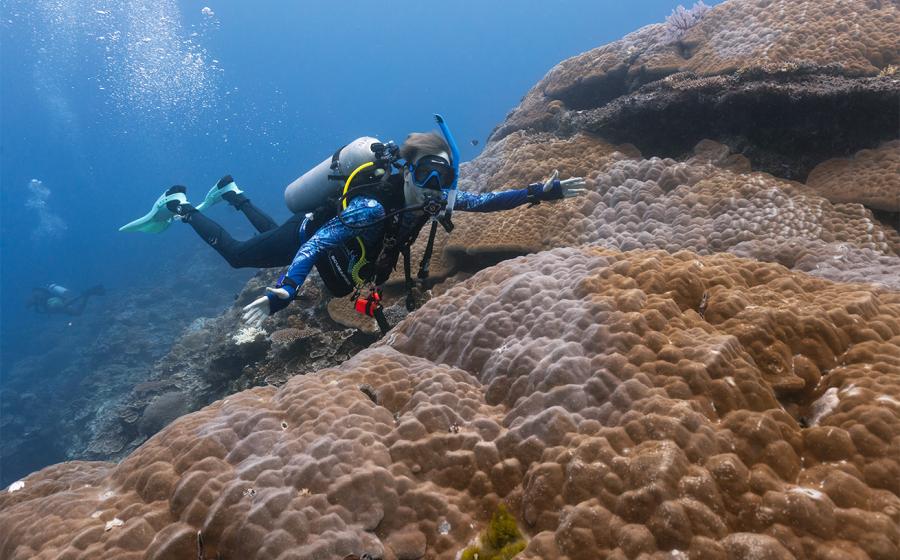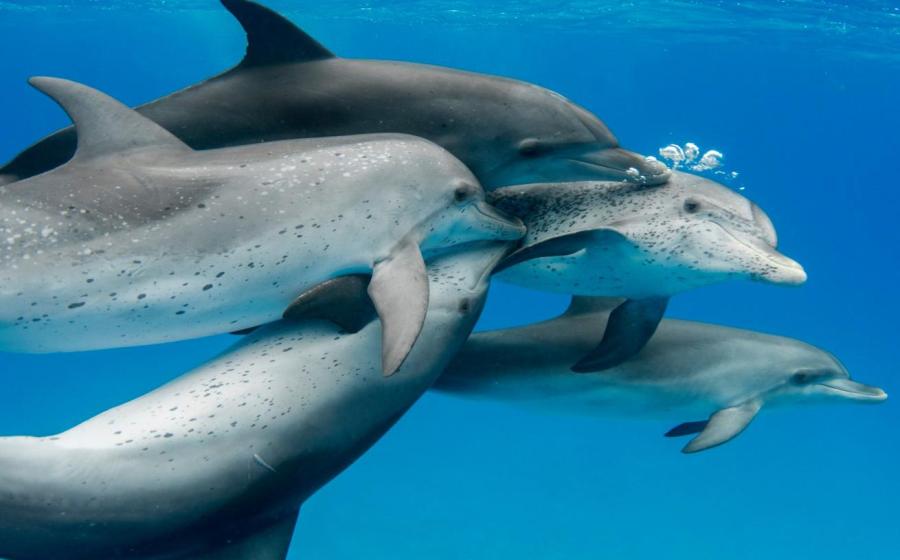Dive with Florida's Goliath Grouper
Another late summer/early fall has come and gone in Florida, and with it goes witnessing another wondrous spawning season for goliath grouper off the Sunshine State's central and southeastern Atlantic coast.
Goliath grouper (also known as “jewfish”) make the trek yearly from as far as northeastern Florida and the Gulf of Mexico to the central/southeast coast of Florida to spawn on the shallower reefs and shipwrecks located there. Goliath grouper, the largest grouper in the Atlantic, are known to return to the same sites like clockwork, so divers can look forward to the event every year.
I’ve met several divers over the years whose only interaction with a goliath grouper was seeing them swim slowly in a huge tank at any number of aquariums throughout the country. One colleague’s wife even confided that she was frightened of them due their large, prehistoric appearance. Goliath grouper can be huge — reaching lengths close to 10 feet (generally the body is half as wide as it is long) and weighing up to 800 pounds — but their demeanor is far from menacing. Grouper are known to be relatively serene, somewhat curious, and mostly sedentary. If threatened or cornered, however, this gentle giant can produce a loud booming sound with its swim bladder, which is known as “barking.” Diving a Florida wreck recently, I swam into the wheelhouse not knowing a grouper had already staked out that territory for his own. I not only heard his warning bark, but I felt it from my head down to my fins! Through my mask I politely excused myself and quietly backed out of the wheelhouse.
During breeding season, aggregations usually contain fewer than 100 individual fish, and the actual spawning occurs on the darkest nights (particularly during the new moon). It is believed that the darker the night, the less predation on the eggs. And while the aggregations declined in prior decades due to overfishing, the grouper population has bounced back due to state and federal protective measures implemented since 1990 and has progressed from a candidate for listing under the Endangered Species Act in 1991 to their current status of “critically endangered.”
Anyone fortunate enough to dive with these majestic fish — in or out of spawning season — is sure to agree the ongoing conservation efforts are vital to ensure future generations can witness the nobility of these kings of the Atlantic.

Craig DietrichGoliath grouper are the largest member of the seabass family in the Atlantic Ocean.
Another late summer/early fall has come and gone in Florida, and with it goes witnessing another wondrous spawning season for goliath grouper off the Sunshine State's central and southeastern Atlantic coast.
Goliath grouper (also known as “jewfish”) make the trek yearly from as far as northeastern Florida and the Gulf of Mexico to the central/southeast coast of Florida to spawn on the shallower reefs and shipwrecks located there. Goliath grouper, the largest grouper in the Atlantic, are known to return to the same sites like clockwork, so divers can look forward to the event every year.

Craig DietrichThe goliath grouper, the largest grouper in the western Atlantic, can grow to lengths longer than eight feet, or roughly the same length as a Smart car.

Craig DietrichThe largest goliath grouper captured in Florida is estimated to have weighed 680 pounds.

Craig DietrichThe goliath grouper can grow to lengths of over eight feet and can weigh as much as 800 pounds.

Craig DietrichGoliath grouper feed mostly on crustaceans (shrimp, crabs and lobsters), fish, octupus, stingrays, parrotfishes and young sea turtles. Prey is ambushed, and caught with a quick rush and a snap of the jaw.

Craig DietrichThe goliath grouper is recognized as a "critically endangered" species on the IUCN Red List of Threatened Species.

Craig DietrichThe Atlantic goliath grouper is found primarily in shallow tropical waters among coral and artificial reefs.

Craig DietrichBefore 2001, the common name of the goliath grouper was the jewfish. This was changed by the American Fisheries Society due to the potentially offensive nature of the name.
I’ve met several divers over the years whose only interaction with a goliath grouper was seeing them swim slowly in a huge tank at any number of aquariums throughout the country. One colleague’s wife even confided that she was frightened of them due their large, prehistoric appearance. Goliath grouper can be huge — reaching lengths close to 10 feet (generally the body is half as wide as it is long) and weighing up to 800 pounds — but their demeanor is far from menacing. Grouper are known to be relatively serene, somewhat curious, and mostly sedentary. If threatened or cornered, however, this gentle giant can produce a loud booming sound with its swim bladder, which is known as “barking.” Diving a Florida wreck recently, I swam into the wheelhouse not knowing a grouper had already staked out that territory for his own. I not only heard his warning bark, but I felt it from my head down to my fins! Through my mask I politely excused myself and quietly backed out of the wheelhouse.

Craig DietrichGoliath grouper tend to spawn in large aggregations, returning like clockwork to the same locations, which makes them vulnerable to mass harvesting. A harvest ban has since been placed on the species.
During breeding season, aggregations usually contain fewer than 100 individual fish, and the actual spawning occurs on the darkest nights (particularly during the new moon). It is believed that the darker the night, the less predation on the eggs. And while the aggregations declined in prior decades due to overfishing, the grouper population has bounced back due to state and federal protective measures implemented since 1990 and has progressed from a candidate for listing under the Endangered Species Act in 1991 to their current status of “critically endangered.”

Craig DietrichGoliath grouper have three to five rows of teeth in the lower jaw. Their sharp teeth are adapted for seizing prey and preventing escape, although most prey are simply engulfed and swallowed whole.
Anyone fortunate enough to dive with these majestic fish — in or out of spawning season — is sure to agree the ongoing conservation efforts are vital to ensure future generations can witness the nobility of these kings of the Atlantic.










